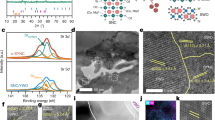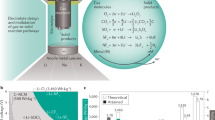Abstract
Fuel cells are attractive alternatives to combustion engines for electrical power generation because of their very high efficiencies and low pollution levels. Polymer electrolyte membrane fuel cells are generally considered to be the most viable approach for mobile applications. However, these membranes require humid operating conditions, which limit the temperature of operation to less than 100 °C; they are also permeable to methanol and hydrogen, which lowers fuel efficiency. Solid, inorganic, acid compounds (or simply, solid acids) such as CsHSO4 and Rb3H(SeO4)2 have been widely studied because of their high proton conductivities and phase-transition behaviour. For fuel-cell applications they offer the advantages of anhydrous proton transport and high-temperature stability (up to 250 °C). Until now, however, solid acids have not been considered viable fuel-cell electrolyte alternatives owing to their solubility in water and extreme ductility at raised temperatures (above approximately 125 °C). Here we show that a cell made of a CsHSO4 electrolyte membrane (about 1.5 mm thick) operating at 150–160 °C in a H2/O2 configuration exhibits promising electrochemical performances: open circuit voltages of 1.11 V and current densities of 44 mA cm-2 at short circuit. Moreover, the solid-acid properties were not affected by exposure to humid atmospheres. Although these initial results show promise for applications, the use of solid acids in fuel cells will require the development of fabrication techniques to reduce electrolyte thickness, and an assessment of possible sulphur reduction following prolonged exposure to hydrogen.
This is a preview of subscription content, access via your institution
Access options
Subscribe to this journal
Receive 51 print issues and online access
$199.00 per year
only $3.90 per issue
Buy this article
- Purchase on Springer Link
- Instant access to full article PDF
Prices may be subject to local taxes which are calculated during checkout




Similar content being viewed by others
References
Wells, A. F. Structural Inorganic Chemistry 3rd edn, 300–303 (Clarendon, Oxford, 1984).
Haile, S. M., Lentz, G., Kreuer, K.-D. & Maier, J. Superprotonic conductivity in Cs3(HS)4)2(H2PO4). Solid State Ion. 77, 128–134 (1995).
Haile, S. M., Calkins, P. M. & Boysen, D. Superprotonic conductivity in β-Cs3(HSO4)2(Hx(P,S)O4). Solid State Ion. 97, 145–151 (1997).
Chisholm, C. R. I. & Haile, S. M. Superprotonic behavior of CsHSO4–CsH2PO4 system. Solid State Ion. 136–137, 229–241 (2000).
Baranov, A. I., Shuvalov, L. A. & Shchagina, N. M. Superion conductivity and phase transitions in CsHSO4 and CsHSeO4 crystals. JETP Lett. 36, 459–462 (1982).
Norby, T., Friesel, M. & Mellander, B. E. Proton and deuteron conductivity in CsHSO4 and CsDSO4 by in situ isotopic exchange. Solid State Ion. 77, 105–110 (1995).
Pawlowski, A., Pawlaczyk, Cz. & Hilzcer, B. Electric conductivity in crystal group Me3H(SeO4)2 (Me: NH+4, Rb+, Cs+). Solid State Ion. 44, 17–19 (1990).
Ramasastry, C. & Ramaiah, A. S. Electrical conduction in Na3H(SO4)2 crystals. J. Mater. Sci. Lett. 16, 2011–2016 (1981).
Chisholm, C. R. I., Merinov, B. V. & Haile, S. M. High temperature phase transitions in K3H(SO4)2. Solid State Ion. (in the press).
Gaskell, D. R. Introduction to Metallurgical Thermodynamics 2nd edn, 574 & 586 (McGraw-Hill, Washington DC, 1981).
Srinivasan, S., Velev, O. A., Parthasarathy, A., Manko, D. J. & Appleby, A. J. High energy efficiency and high power density proton exchange membrane fuel cells—electrode kinetics and mass transport. J. Power Sources 36, 299–320 (1991).
Croce, F. & Cigna, G. Determination of the protonic transference number for KH2PO4 by electromotive force measurements. Solid State Ion. 6, 201–202 (1982).
Minh, N. Q. Ceramic fuel cells. J. Am. Ceram. Soc. 76, 563–588 (1993).
Minh, N. Q. & Horne, C. R. in Proc. 14th Risø Int. Symp. on Materials Science: High Temperature Electrochemical Behaviour of Fast Ion and Mixed Conductors (eds Poulsen, F. W., Bentzen, J. J., Jacobsen, T., Skou, E. & Østergård, M. J. L.) 337–341 (Risø National Laboratory, Roskilde, 1993).
Baranov, A. I., Khiznichenko, V. P., Sandler, V. A. & Shuvalov, L. A. Frequency dielectric dispersion in the ferroelectric and superionic phases of CsH2PO4. Ferroelectrics 81, 183–186 (1988).
Slade, R. C. T. & Omana, M. J. Protonic conductivity of 12-tungstophosphoric acid (TPA, H3PW12O40) at elevated temperatures. Solid State Ion. 58, 195–199 (1992).
Haile, S. M., Narayanan, S. R., Chisholm, C. & Boysen, D. Proton conducting membrane using a solid acid. US patent 09/439,377 (15 Nov. 2000).
Acknowledgements
We thank J. Snyder for assistance with computer automation of the fuel cell test station and S. R. Narayanan for technical discussions. Financial support has been provided by the California Institute of Technology through the Yuen Grubstake entrepreneurial fund.
Author information
Authors and Affiliations
Corresponding author
Supplementary information
Supplementary figure
Cell voltage versus current density (polarization curves) for several CsHSO4 fuel cells with differing Pt loadings operated under the conditions indicated. Platinum content was varied by changing the thickness of the electrode layer while maintaining the overall composition. (JPG 39 kb)
Rights and permissions
About this article
Cite this article
Haile, S., Boysen, D., Chisholm, C. et al. Solid acids as fuel cell electrolytes. Nature 410, 910–913 (2001). https://doi.org/10.1038/35073536
Received:
Accepted:
Issue Date:
DOI: https://doi.org/10.1038/35073536
This article is cited by
-
CSA@g-C3N4 as a novel, robust and efficient catalyst with excellent performance for the synthesis of 4H-chromenes derivatives
Scientific Reports (2023)
-
Urea electrooxidation: Research progress and application of supported nickel-based catalysts
Ionics (2023)
-
Overcoming the Electrode Challenges of High-Temperature Proton Exchange Membrane Fuel Cells
Electrochemical Energy Reviews (2023)
-
Hydride-ion-conducting K2NiF4-type Ba–Li oxyhydride solid electrolyte
Nature Materials (2022)
-
Ab Initio Molecular Dynamics Studies of the Electric-Field-Induced Catalytic Effects on Liquids
Topics in Catalysis (2022)
Comments
By submitting a comment you agree to abide by our Terms and Community Guidelines. If you find something abusive or that does not comply with our terms or guidelines please flag it as inappropriate.



